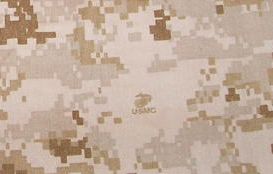Camouflage pattern MARPAT™ Digital desert
The camouflage pattern MARPAT™ (also known as "MARine PATtern") is used by the USMC, as well as some other countries (Bosnia and Herzegovina). The development of the MARPAT™ camouflage pattern began around the year 2000, when the United States Marine Corps (USMC) aimed to create and deploy the best possible camouflage pattern for their soldiers.

Country of deployment: The most well-known user is undoubtedly the USMC, but other countries like Hercegovina and Bosnia also use it.
This entire demanding process began with a thorough study of camouflage patterns existing around the world. The USMC eventually decided to give a chance to three camouflage patterns: specifically, the Vietnamese "tiger stripes," a commercial version of "tiger stripes," and the Rhodesian variant of the British DPM (Disruptive Pattern Material).
The aforementioned camouflage patterns were taken to a textile factory where they were scanned and then further digitally modified. Additional tests, however, demonstrated that by far the most suitable for further modifications would be only the Rhodesian variation on DPM. This occurred despite many people thinking that the USMC deserved something better than just a modified camouflage pattern. Fortunately, at that time, the Canadian CADPAT emerged, within which Canada later collaborated with the USA, resulting in the creation of the MARPAT™ camouflage pattern.
Which modern army first introduced digital camouflage?
The overall concept of digital camouflage (i.e., military camouflage designed using computer algorithms rather than traditional natural motifs and colors + pixels creating a dynamic "drawing within a drawing" from a distance) was first introduced in 1996 by the Canadian government. They commissioned a study on this topic and found that digital camouflage patterns cover better than traditional natural organics.
As you well know, during this time, the USMC was also searching for a new camouflage pattern, so they eventually decided in collaboration with Canada on the MARPAT™ camouflage pattern project (adoption began around 2001-2005). It is practically based perfectly on the Canadian CADPAT, and the USMC tested a total of four camouflage schemes: MARPAT™ Woodland, MARPAT™ Desert, MARPAT™ Winter, and MARPAT™ Urban (tested but ultimately not adopted).
Any of the MARPAT™ series camouflage patterns are easily recognizable: they also have as part of the design the USMC EGA logo.




























































































































